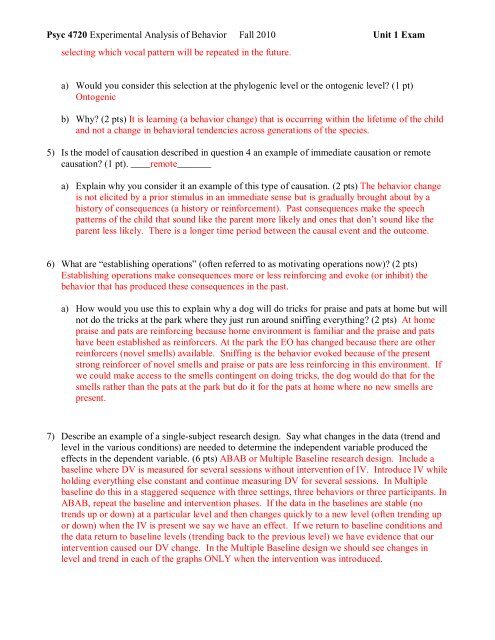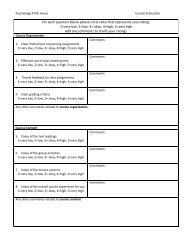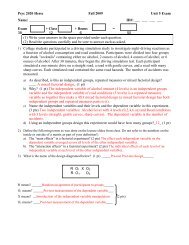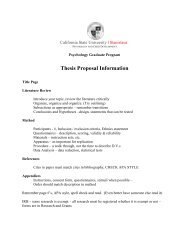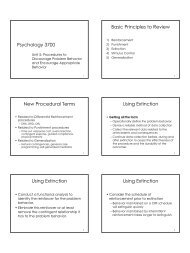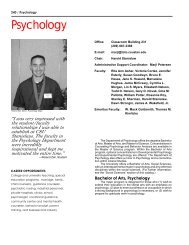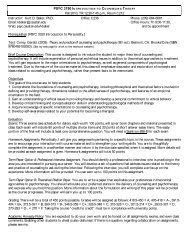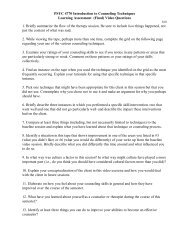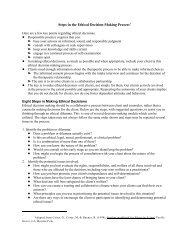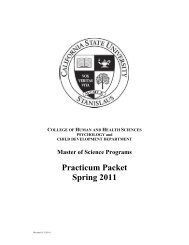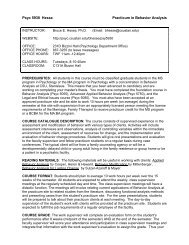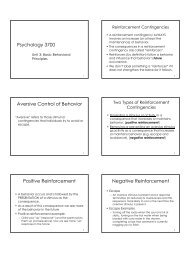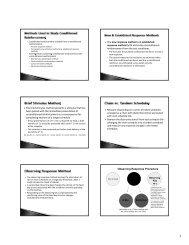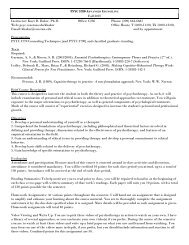(1) Leave a one inch margin on the left side of your answer sheet
(1) Leave a one inch margin on the left side of your answer sheet
(1) Leave a one inch margin on the left side of your answer sheet
Create successful ePaper yourself
Turn your PDF publications into a flip-book with our unique Google optimized e-Paper software.
Psyc 4720 Experimental Analysis <strong>of</strong> Behavior Fall 2010 Unit 1 Exam<br />
selecting which vocal pattern will be repeated in <strong>the</strong> future.<br />
a) Would you c<strong>on</strong><strong>side</strong>r this selecti<strong>on</strong> at <strong>the</strong> phylogenic level or <strong>the</strong> <strong>on</strong>togenic level? (1 pt)<br />
Ontogenic<br />
b) Why? (2 pts) It is learning (a behavior change) that is occurring within <strong>the</strong> lifetime <strong>of</strong> <strong>the</strong> child<br />
and not a change in behavioral tendencies across generati<strong>on</strong>s <strong>of</strong> <strong>the</strong> species.<br />
5) Is <strong>the</strong> model <strong>of</strong> causati<strong>on</strong> described in questi<strong>on</strong> 4 an example <strong>of</strong> immediate causati<strong>on</strong> or remote<br />
causati<strong>on</strong>? (1 pt). ____remote_______<br />
a) Explain why you c<strong>on</strong><strong>side</strong>r it an example <strong>of</strong> this type <strong>of</strong> causati<strong>on</strong>. (2 pts) The behavior change<br />
is not elicited by a prior stimulus in an immediate sense but is gradually brought about by a<br />
history <strong>of</strong> c<strong>on</strong>sequences (a history or reinforcement). Past c<strong>on</strong>sequences make <strong>the</strong> speech<br />
patterns <strong>of</strong> <strong>the</strong> child that sound like <strong>the</strong> parent more likely and <str<strong>on</strong>g><strong>on</strong>e</str<strong>on</strong>g>s that d<strong>on</strong>’t sound like <strong>the</strong><br />
parent less likely. There is a l<strong>on</strong>ger time period between <strong>the</strong> causal event and <strong>the</strong> outcome.<br />
6) What are “establishing operati<strong>on</strong>s” (<strong>of</strong>ten referred to as motivating operati<strong>on</strong>s now)? (2 pts)<br />
Establishing operati<strong>on</strong>s make c<strong>on</strong>sequences more or less reinforcing and evoke (or inhibit) <strong>the</strong><br />
behavior that has produced <strong>the</strong>se c<strong>on</strong>sequences in <strong>the</strong> past.<br />
a) How would you use this to explain why a dog will do tricks for praise and pats at home but will<br />
not do <strong>the</strong> tricks at <strong>the</strong> park where <strong>the</strong>y just run around sniffing everything? (2 pts) At home<br />
praise and pats are reinforcing because home envir<strong>on</strong>ment is familiar and <strong>the</strong> praise and pats<br />
have been established as reinforcers. At <strong>the</strong> park <strong>the</strong> EO has changed because <strong>the</strong>re are o<strong>the</strong>r<br />
reinforcers (novel smells) available. Sniffing is <strong>the</strong> behavior evoked because <strong>of</strong> <strong>the</strong> present<br />
str<strong>on</strong>g reinforcer <strong>of</strong> novel smells and praise or pats are less reinforcing in this envir<strong>on</strong>ment. If<br />
we could make access to <strong>the</strong> smells c<strong>on</strong>tingent <strong>on</strong> doing tricks, <strong>the</strong> dog would do that for <strong>the</strong><br />
smells ra<strong>the</strong>r than <strong>the</strong> pats at <strong>the</strong> park but do it for <strong>the</strong> pats at home where no new smells are<br />
present.<br />
7) Describe an example <strong>of</strong> a single-subject research design. Say what changes in <strong>the</strong> data (trend and<br />
level in <strong>the</strong> various c<strong>on</strong>diti<strong>on</strong>s) are needed to determine <strong>the</strong> independent variable produced <strong>the</strong><br />
effects in <strong>the</strong> dependent variable. (6 pts) ABAB or Multiple Baseline research design. Include a<br />
baseline where DV is measured for several sessi<strong>on</strong>s without interventi<strong>on</strong> <strong>of</strong> IV. Introduce IV while<br />
holding everything else c<strong>on</strong>stant and c<strong>on</strong>tinue measuring DV for several sessi<strong>on</strong>s. In Multiple<br />
baseline do this in a staggered sequence with three settings, three behaviors or three participants. In<br />
ABAB, repeat <strong>the</strong> baseline and interventi<strong>on</strong> phases. If <strong>the</strong> data in <strong>the</strong> baselines are stable (no<br />
trends up or down) at a particular level and <strong>the</strong>n changes quickly to a new level (<strong>of</strong>ten trending up<br />
or down) when <strong>the</strong> IV is present we say we have an effect. If we return to baseline c<strong>on</strong>diti<strong>on</strong>s and<br />
<strong>the</strong> data return to baseline levels (trending back to <strong>the</strong> previous level) we have evidence that our<br />
interventi<strong>on</strong> caused our DV change. In <strong>the</strong> Multiple Baseline design we should see changes in<br />
level and trend in each <strong>of</strong> <strong>the</strong> graphs ONLY when <strong>the</strong> interventi<strong>on</strong> was introduced.


